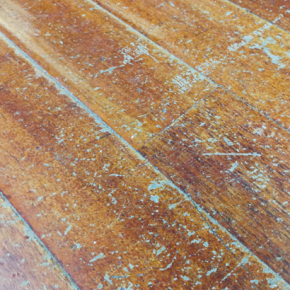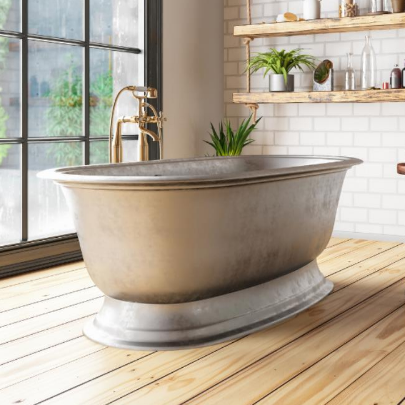
GUEST ARTICLE: 10 most common flooring mistakes
Floors are often an underappreciated element within our living areas. Let’s be honest, they have to cope with a lot, from heavy foot traffic to frequent spillages, but they can also make a big difference to the aesthetics of a room. A bad flooring installation can stick out like a sore thumb and make a space look bad. Here are 10 flooring mistakes you should avoid at all costs…
10 Common mistakes
1. Not preparing your subfloor
A subfloor is just like the foundations of a house. Without a strong and sturdy foundation, your floors will suffer. Whether it’s loose creaking floorboards, excessive moisture, or an uneven or unlevel surface, a good flooring installation is only as good as the subfloor that it’s installed on.
Before installing your floor, you must always check the quality of the subfloor. A subfloor should be completely dry, clean, and level. Otherwise, imperfections will start showing through, creating many problems. Subfloor preparation is vital for long lasting performance.
2. Picking the wrong flooring for its function
It can be a tough decision to choose a floor with so many different flooring options available. Yet a flooring mistake many will make is picking the wrong flooring type for its desired function.
Choosing the wrong flooring can make a space look worn and ruin the look of an otherwise perfectly decorated room. Whether it’s choosing a floor that is not practical or not designed for specific conditions, you should consider how durable a floor is.

Examples of picking the wrong flooring for its function can include:
– Installing hardwood in a moist room, such as a bathroom. Hardwood floors are not designed to withstand moisture.
– Installing carpets in kitchens. Fabric flooring, such as carpet, can easily be stained and marked.
– Installing soft flooring in heavy usage and high-traffic areas. Laminate flooring can scratch when scrapped with furniture or dent under excessive weight.
Find out what’s the best flooring for home offices.
3. Wrong colour choice
Alongside picking the wrong flooring type, another common flooring mistake is choosing the wrong colour. The design and colour of a floor should help complement a space, not go against it.
Not only does the colour need to reflect its purpose, but it needs to compliment your existing décor and design. A flooring choice may look different in the shop or online. That’s why it’s always important to make use of samples to check if flooring goes well in a chosen room.
4. Improper cleaning and maintenance
Installation is only half the job of creating a quality flooring installation. Cleaning and maintaining floors are equally important for getting the best out of a floor, yet this is often overlooked and not done correctly.
Either not cleaning and maintaining your floors or excessively cleaning them is one of the first major mistakes. The second is using the wrong cleaning products on a floor which can cause permanent damage or discolouration. Always read the label to check a product is safe for usage on your floor.
Using excessive amounts of water can also be a problem. Flooring types, such as wood flooring, are not designed for excessive moisture. Floors that also have joins present are also likely to experience water damage as well. Limiting the amount of water you use can help eliminate this mistake.
5. Price over quality
Another common flooring mistake is choosing a cheap flooring option. Those who may have a limited budget or looking to save money may go for a cheaper option. However, in the case of flooring, you get what you pay for.
Cheaper flooring options usually relate to poor quality. The same goes for underlay. It may seem appealing at the time, but cheaper options do not last long-term. Cheaper flooring will showcase scratches, wear, and tear much more easily.
In the end, you will need to replace a cheaper floor much sooner. Spending that bit extra in the first place will help you to save money in the long term (providing it is correctly maintained).
6. Bad DIY job
Some flooring choices, including loose-lay vinyl flooring, are types of flooring that can be installed easily and quickly. Many may be tempted to install these easy flooring types themselves, providing a Saturday afternoon or rainy-day DIY job.
But most people will either make mistakes in installing the flooring or start the job and leave it unfinished. How many times has that happened? You may be surprised that this is another top flooring mistake.
If you lack experience in installing flooring or don’t feel up to the task of finishing the job, it is best to get a professional in. Hiring a professional fitter will ensure the job gets completed and to a high standard.
7. The wrong tools for the job
Not only are bad DIY jobs a common flooring mistake, but those who do undertake the job themselves usually have the wrong tools for the job.
Making do with the tools you have in your shed is likely to result in disappointment and extra costs! A quality flooring installation will require professional tools, such as a jigsaw, rubber mallet, tapping block, spirit level, spacers, etc. depending on the job being done.
Unless you have these at hand, or are willing to hire or purchase them, leave it to the professionals. Making do simply won’t do if you want a quality floor installation that lasts. In this case, a bad workman really can blame his tools.
8. Choosing the wrong flooring contractor
Choosing a flooring contractor can be just as difficult decision as picking the flooring itself. With so many about, how do you know which one to choose? You’d be surprised how many people have chosen the wrong flooring contractor. No cowboys here, please!
You’ll likely shop around and get a few quotes from different contractors. Choosing the cheapest contractor is the first (and one of the most common) mistake. Choosing the cheapest is a recipe for disaster and will usually lead to poor results.
A quote factors in the price of both materials (if you haven’t supplied the floor already) and labour. A cheap price will usually result in poorer quality materials and a rushed job that can leave a myriad of mistakes and faults. Experienced installers will know which materials are the best and how to achieve a quality installation, and their cost will reflect this.
9. Not letting the floor acclimate and expand
Some flooring types, such as hardwood and laminate, require time to acclimate. Acclimating flooring involves adapting it to the environment before installing it. Acclimating allows a floor to adapt to the environment, room temperature, and humidity.
Not acclimating your floor is an overlooked part of a flooring installation and another common mistake. Before installing your floor, you should let it acclimate for around 3 days. Failing to acclimate your floor can lead to warping and excessive movement once installed.
Floors, such as wooden floors, naturally expand and contract according to the temperature. That is why it’s also important that sufficient breathing space is left around the edges of a room and across the joints. Allowing for expansion and subtle movement will ensure your floor lasts for a long time.
10. Furniture damage
Furniture damage is another factor that people will often overlook. You’ve just had a new expensive floor installed and before you know it, that armchair you’ve just moved while switching the room layout has scratched your floor.
Fortunately, there is a way you can avoid this devastating mistake. Padding your furniture will help eliminate any potential scratching and scrapes on your floor. Floor pads provide a cheap and handy option for protecting your floor.
These handy little patches can be added to any furniture items (especially those with legs) and also make the job of switching a room layout much easier, especially if you’re into Feng Shui. You won’t need to worry about floor scratches with pads.
If you are thinking of changing your flooring or looking to remodel a room, keep these flooring mistakes in mind. If you want to enjoy a quality flooring installation that is sure to last, make sure you try to avoid these common mistakes. And remember, if in doubt, go without. Your floors will thank you for it!
Latest news

28th March 2025
Ideal Heating Commercial announces 10-year warranty on Evomax 2 boiler
Evomax 2, the UK’s number one selling commercial wall-mounted boiler from Ideal Heating Commercial, is now available with a 10-year warranty.
Posted in Articles, Building Industry News, Building Products & Structures, Building Regulations & Accreditations, Building Services, Facility Management & Building Services, Heating Systems, Controls and Management, Heating, Ventilation and Air Conditioning - HVAC, Innovations & New Products, Pipes, Pipes & Fittings, Plumbing, Retrofit & Renovation, Sustainability & Energy Efficiency, Videos
28th March 2025
FLIR Si1-LD Acoustic Imaging Camera for Compressed Air Leak Detection
FLIR, a Teledyne Technologies company, introduces the Si1-LD, an industrial acoustic imaging camera that brings faster and more accurate compressed air leak detection to those operating on a modest condition monitoring budget.
Posted in Acoustics, Noise & Vibration Control, Articles, Building Industry News, Building Products & Structures, Building Services, Facility Management & Building Services, Information Technology, Innovations & New Products, Retrofit & Renovation, Sustainability & Energy Efficiency, Thermal Imaging and Monitors
28th March 2025
LIFTEX 2025 Seminar programme announced
Registration has opened for LIFTEX 2025. Now in its 37th year, LIFTEX 2025 is the UK’s only dedicated exhibition for the lift, escalator and access industry and takes place only once every three years.
Posted in Access Control & Door Entry Systems, Accessibility, Articles, Building Industry Events, Building Industry News, Building Products & Structures, Building Regulations & Accreditations, Building Services, Exhibitions and Conferences, Facility Management & Building Services, Health & Safety, Retrofit & Renovation, Security and Fire Protection, Seminars
28th March 2025
MCRMA welcomes ArcelorMittal UK to membership
A UK division of the global steelmaking business ArcelorMittal has become the latest new member of the MCRMA, the industry association representing the metal building envelope sector.
Posted in Articles, Building Associations & Institutes, Building Industry News, Building Products & Structures, Building Systems, Cladding, Facades, Posts, Restoration & Refurbishment, Retrofit & Renovation, Roofs, Steel and Structural Frames, Walls
 Sign up:
Sign up: